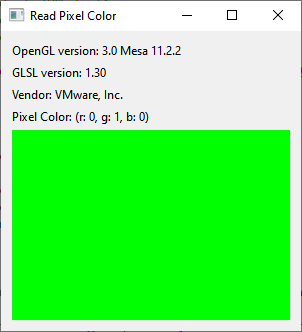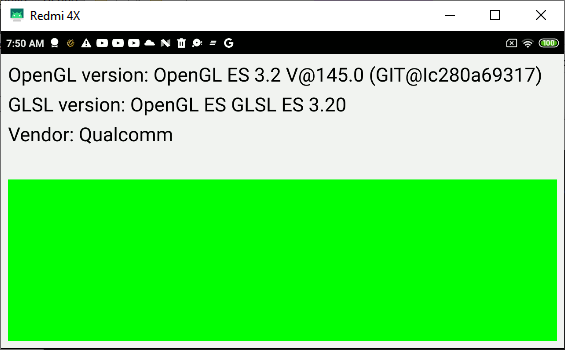Hi,
My example works on Desktop. It prints a color of a pixel with (0, 0) coordinates and OpenGL version:

But when I switch to Android I have these errors when I build:
main.cpp:45:27: error: use of undeclared identifier 'GL_DRAW_FRAMEBUFFER'
main.cpp:50:27: error: use of undeclared identifier 'GL_DRAW_FRAMEBUFFER'
main.cpp:52:27: error: use of undeclared identifier 'GL_READ_FRAMEBUFFER'
main.cpp:57:22: error: use of undeclared identifier 'GL_READ_FRAMEBUFFER'
I connected the Redmi 4X phone using USB cable. This is a screenshot that I made on laptop using the scrcpy program. This screenshot shows that my device supports OpenGL ES 3.2:

main.cpp
#include <QtGui/QOpenGLExtraFunctions>
#include <QtGui/QSurfaceFormat>
#include <QtGui/QVector3D>
#include <QtOpenGL/QOpenGLFramebufferObject>
#include <QtWidgets/QApplication>
#include <QtWidgets/QLabel>
#include <QtWidgets/QWidget>
#include <QtWidgets/QVBoxLayout>
#include <QtOpenGLWidgets/QOpenGLWidget>
class OpenGLWidget : public QOpenGLWidget, private QOpenGLExtraFunctions
{
Q_OBJECT
public:
OpenGLWidget()
{
QSurfaceFormat surfaceFormat;
surfaceFormat.setSamples(4);
setFormat(surfaceFormat);
}
signals:
void showInfoSignal(const QString &openGLVersion, const QString &shadingVersion,
const QString &vendor);
void showPixelColorSignal(const QVector3D &color);
private:
void initializeGL() override
{
initializeOpenGLFunctions();
glClearColor(0.f, 1.f, 0.f, 1.f);
m_fbo.reset(new QOpenGLFramebufferObject(1, 1));
QString version(QString("OpenGL version: %1").arg((const char*) glGetString(GL_VERSION)));
QString shadingLanguageVersion(QString("GLSL version: %1")
.arg((const char*) glGetString(GL_SHADING_LANGUAGE_VERSION)));
QString vendor(QString("Vendor: %1").arg((const char*) glGetString(GL_VENDOR)));
emit showInfoSignal(version, shadingLanguageVersion, vendor);
}
void paintGL() override
{
glClear(GL_COLOR_BUFFER_BIT);
// Set draw buffer to be fbo. Read buffer is already the default one
glBindFramebuffer(GL_DRAW_FRAMEBUFFER, m_fbo->handle());
// Blit from the default MSAA buffer to non-MSAA fbo
glBlitFramebuffer(0, 0, m_fbo->width(), m_fbo->height(),
0, 0, m_fbo->width(), m_fbo->height(),
GL_COLOR_BUFFER_BIT, GL_NEAREST);
glBindFramebuffer(GL_DRAW_FRAMEBUFFER, context()->defaultFramebufferObject());
// Set read buffer
glBindFramebuffer(GL_READ_FRAMEBUFFER, m_fbo->handle());
// Read the pixel
GLubyte pixel[4];
glReadPixels(0, 0, 1, 1, GL_RGBA, GL_UNSIGNED_BYTE, pixel);
// Set read buffer back to default
glBindBuffer(GL_READ_FRAMEBUFFER, context()->defaultFramebufferObject());
emit showPixelColorSignal(QVector3D(pixel[0] / 255.f, pixel[1] / 255.f, pixel[2] / 255.f));
}
private:
std::unique_ptr<QOpenGLFramebufferObject> m_fbo;
};
class MainWindow : public QWidget
{
Q_OBJECT
public:
MainWindow()
{
resize(300, 300);
setWindowTitle("Read Pixel Color");
m_openGLVersionLabel = new QLabel();
m_shadingLanguageVersionLabel = new QLabel();
m_vendorLabel = new QLabel();
m_pixelColorLabel = new QLabel();
OpenGLWidget *openGLWidget = new OpenGLWidget();
m_openGLVersionLabel->setSizePolicy(QSizePolicy::Policy::Fixed, QSizePolicy::Policy::Fixed);
m_shadingLanguageVersionLabel->setSizePolicy(QSizePolicy::Policy::Fixed,
QSizePolicy::Policy::Fixed);
m_vendorLabel->setSizePolicy(QSizePolicy::Policy::Fixed, QSizePolicy::Policy::Fixed);
m_pixelColorLabel->setSizePolicy(QSizePolicy::Policy::Fixed, QSizePolicy::Policy::Fixed);
QVBoxLayout *layout = new QVBoxLayout();
layout->addWidget(m_openGLVersionLabel);
layout->addWidget(m_shadingLanguageVersionLabel);
layout->addWidget(m_vendorLabel);
layout->addWidget(m_pixelColorLabel);
layout->addWidget(openGLWidget);
setLayout(layout);
connect(openGLWidget, &OpenGLWidget::showPixelColorSignal,
this, &MainWindow::showPixelColorSlot);
connect(openGLWidget, &OpenGLWidget::showInfoSignal, this, &MainWindow::showInfoSlot);
}
private slots:
void showInfoSlot(const QString &openGLVersion, const QString &shadingVersion,
const QString &vendor)
{
m_openGLVersionLabel->setText(openGLVersion);
m_shadingLanguageVersionLabel->setText(shadingVersion);
m_vendorLabel->setText(vendor);
}
void showPixelColorSlot(const QVector3D &color)
{
m_pixelColorLabel->setText(QString("Pixel Color: (r: %1, g: %2, b: %3)")
.arg(color.x()).arg(color.y()).arg(color.x()));
}
private:
QLabel *m_openGLVersionLabel;
QLabel *m_shadingLanguageVersionLabel;
QLabel *m_vendorLabel;
QLabel *m_pixelColorLabel;
};
#include "main.moc"
int main(int argc, char *argv[])
{
QApplication app(argc, argv);
MainWindow w;
w.show();
return app.exec();
}
pro
QT += core gui openglwidgets widgets
win32: LIBS += -lopengl32
CONFIG += c++17
SOURCES += \
main.cpp
TARGET = app


